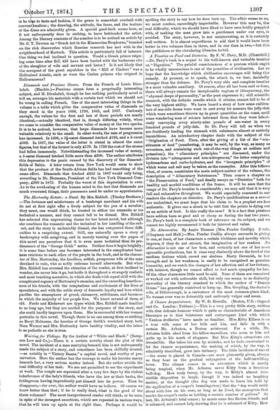Halicarnassus? remedy. At present, so to speak, the attack is,
we fear, decidedly
Diamonds and Precious Stones. From the French of Louis Dieu- stronger than the defence. Dr. Pavy's very able and complete treatise lafait. (Blackie.)—Precious stones form a perpetually interesting is a most valuable auxiliary. Of course, after all has been said or done, subject, and M. Dieulafait, though he has nothing particularly novel to there will always remain the inexplorable regions of idiosyncrasy, the tell us, arranges his materials with a certain tact which we should not "abysmal deeps of personality," as the poet expresses it ; still scientific be wrong in calling French. One of the most interesting things in the research, with the definite results which it attains, cannot fail to be of volume is a table which Ores the comparative value of diamonds as the very highest utility. We have hoard a story of how some oultiva- they stood in the years 1606, 1750, 1865, and 1867. Curiously tors of sea-side farms were wont to cart away for manure the jelly-fish enough, the values for the first and last of these periods are nearly which were sometimes thrown up in great quantities on the coast, until identical,—actually identical, that is, though differing widely, when some wandering man of science informed them that they were labori- we come to consider the comparative value of money at the two epochs. only conveying away ninety-nine pounds of sea-water in every It is to be noticed, however, that large diamonds have become more hundred pounds of jelly-fish. So Dr. Pavy will tell us when we -valuable relatively to the small. In other words, the rate of progression are fruitlessly loading the stomach with substances almost or entirely has increased. In 1606, a 3i-carat diamond fetched £196, and a 5-carat nutrition. An introductory chapter deals with the subject of the £349. In 1867, the value of the latter is stated in almost the same " Origination of Food. Then, after the giving of a list of the " con- figures, but that of the former is only £176. In 1750 the cost of the stones stituents of food " (numbering, it may be said, by the way, as many as had fallen immensely. Notwithstanding the increased value of money, seventeen, and containing such out-of-the-way things as sodium and a 5-carat diamond fetched little more than £200. The author attributes Potassium), the " alimentary principles " are discussed, under the this depression to the panic caused by the discovery of the diamond- division into " nitrogenous and non-nitrogenous," the latter comprising fields of Bahia. A later return from New York would seem to show hydrocarbons and carbo-hydrates, and the "inorganic principles" of that the produce of the South-African fields has had something of the which water and salt may be taken as the examples. After this follows -same effect. Diamonds that fetched £352 in 1867 would only bring, what, of course, constitutes the main subject-matter of the volume, the according to Mr. Hermann, President of the New York Diamond Com- description of "Alimentary Substances." Then comes a chapter on pany, aso in 1872. Probably the worst of this depreciation is over. "the Preservation of Food," and finally essays on "Dietetics " both for As to the awakening of the human mind to the fact that diamonds are healthy and morbid conditions of the frame. It will be seen that the mach overratecl things, their possessors need be under no apprehension. range of Dr. Pavy's treatise is considerable ; we may add that it is very
full and exhaustive throughout. We would especially commend to our


































 Previous page
Previous page